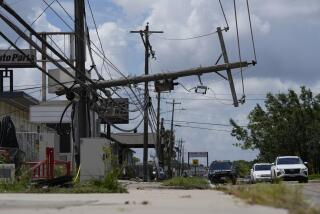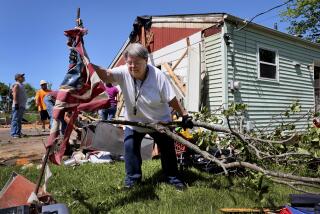Second major storm in three days hits northern Europe, killing at least nine people

The second major storm in three days smashed through northern Europe on Friday, killing at least nine people as high winds felled trees, canceled train services and ripped sections off the roof of London’s O2 Arena.
The U.K. weather service said a gust provisionally measured at 122 mph, thought to be the strongest ever in England, was recorded on the Isle of Wight as Storm Eunice swept across the country’s south. The weather system, known as Storm Zeynep in Germany, is now pushing into the European mainland, prompting high wind warnings in Belgium, the Netherlands, Denmark and Germany.
The storm caused mayhem with travel in Britain, shutting the English Channel port of Dover, closing bridges linking England and Wales, and halting most trains in and out of London.
At least three people died in Britain, including a man in southern England killed when a car hit a tree, a man whose windshield was struck by debris in northwest England, and a woman in her 30s who died in London when a tree fell on a car, police said.
In the Netherlands, firefighters said three people were killed by falling trees in and around Amsterdam, and a fourth died in the northern province of Groningen after driving his car into a fallen tree.
In neighboring Belgium, an elderly man died when high winds pushed him into a canal in Ypres. In County Wexford, Ireland, a local government worker was killed as he responded to the scene of a fallen tree, the local council said.
Eunice is the second named storm to hit Europe this week, with the first storm killing at least five people in Germany and Poland.
Peter Inness, a meteorologist at the University of Reading in England, attributed the storms to an unusually strong jet stream over the eastern Atlantic Ocean, with winds close to 200 mph at high altitudes.
“A strong jet stream like this can act like a production line for storms, generating a new storm every day or two,” Inness said. “There have been many occasions in the recent past when two or more damaging storms have passed across the U.K. and other parts of Europe in the space of a few days.”
The forecast led British authorities to take the unusual step of issuing ”red” weather warnings — indicating a danger to life — for parts of southern England, including London, and Wales that lasted through early afternoon. A lower-level amber warning for gusts up to 80 mph covers the whole of England from 5 a.m. to 9 p.m.
Even before Britain was hit by the full force of the storm, Eunice disrupted travel across southern England and Wales with many train services interrupted and numerous flights and ferry services canceled. A number of tourist attractions in England, including the London Eye, Legoland and Warwick Castle, closed ahead of the storm, as were all of London’s Royal Parks.
In the town of Wells in southwest England, the wind toppled the spire of a 19th-century church. In London, high winds ripped sections of roofing from the O2 Arena, a landmark on the south bank of the River Thames that was originally known as the Millennium Dome. Firefighters evacuated 1,000 people from the area.
“I urge all Londoners to stay at home, do not take risks, and do not travel unless it is absolutely essential,″ Mayor Sadiq Khan said before the storm.
The Environment Agency issued 10 severe flood warnings, another indicator of life-threatening weather conditions.
The storm was expected to hit northern Germany later Friday and sweep eastward overnight. A flood warning was issued for Germany’s North Sea coast. Meteorologists warned the storm could cause more damage than the earlier weather system, which triggered accidents that killed at least three people, toppled trees and damaged roofs and railroad tracks.
Germany’s biggest rail operator, Deutsche Bahn, canceled all train services in the north of the country.
In the Netherlands, authorities sent a push alert to mobile phone users on Friday afternoon, warning them to stay indoors.
The Dutch weather institute earlier issued its highest warning, code red, for coastal regions and code orange for much of the rest of the low-lying nation. The country’s rail company said it would halt all trains nationwide from 2 p.m. The airline KLM canceled dozens of flights at Amsterdam’s Schiphol Airport.
In Denmark, strong winds prompted authorities to ban light vehicles from crossing the Storebælt tunnel and bridge linking the central island of Funen to Zealand, home to the capital, Copenhagen.
Storm Eunice produced heightened concern because it had the potential to produce a “sting jet,” a small area of intense winds that may exceed 100 mph.
One example of such a phenomenon occurred during what’s known as the Great Storm of 1987, which killed 18 people and knocked down 15 million trees across the U.K., according to the Met Office.
Liz Bentley, chief executive of the Royal Meteorological Society, described the phenomenon as being akin to a scorpion in the sky.
“It’s often referred to as a sting jet because it’s like it’s the sting in the tail as the storm moves through,” she said. “And that’s usually the bit where the strong winds are — right on the tip of that curl of cloud.”
Associated Press writers Mike Corder in The Hague, Frank Jordans in Berlin, Jill Lawless in London, Raf Casert in Brussels and Jan M. Olsen in Copenhagen contributed to this report.
More to Read
Sign up for Essential California
The most important California stories and recommendations in your inbox every morning.
You may occasionally receive promotional content from the Los Angeles Times.






